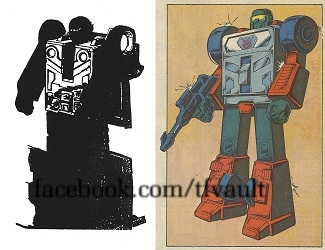
Last time we looked at how the Aerialbots were presented in the pre-Movie 1985 Transformers Show Bible and how a lot of more and less familiar elements of their designs made their progress through the designs. This time we are taking a look at the Stunticons in this - for now - last part in the series.
The Stunticons
The Aerialbots and the Stunticons made their appearance at almost the same time in all the media at the time pairing off against each other in both the cartoon series and the Marvel comic book. Curiously though, the images shown for the Stunticons in the Show Bible are not toy photographs traced in pen, they are in fact a step earlier than actual toys, namely design sketches.
Again the design images are bad photocopies of bad photocopies so there is little to be done to enhance the images, but already with the first two members of the Stunticon team presented here, Dead End and Wildrider, we can see where some of the inspiration came from for their final character model depictions.

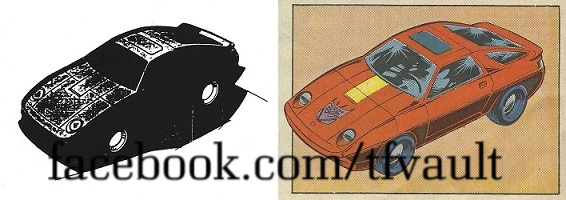
Clearly, the color scheme (or one very close to it) was already decided for the characters as all dark areas on the sketches are equally dark on the models. While the basic stance of the robot has been spruced up a bit in the profiles the design sketches only try to visualize the toys and not their cartoon/comic book appearance some small design elements do shine through that are evident in the later character models and help define the looks of the characters as we know them today: For both Dead End and Wildrider, some strong elements of the facial designs were kept, as Dead End has a clear lighter bar for his eyes which became his visor on the model, whereas Wildrider kept his ear antennae throughout.
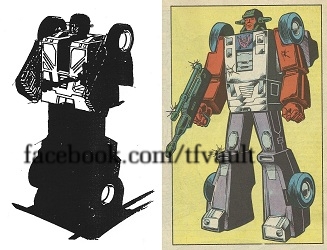
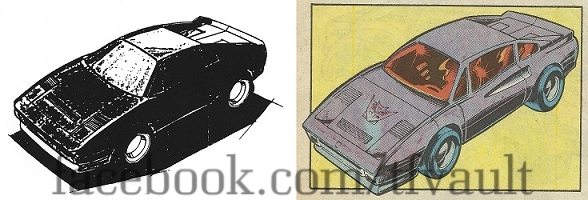
Needless to say, the car mode images are basically straight tracings lifted directly from those toy design sketches, keeping the same angle of view even. One could argue that the 3/4 angle view is the standard way to depict characters as it allows for maximum detail and depth perception during the design proces, but the exact tracing of those same details (at least for the vehicle image) in the final artwork seems more than coincidental.
Moving on to Drag Strip, his vehicle mode alone is yet again simply traced and cleaned up for the character model sheet, which in turn was inked by Marvel Comics for his Transformers Universe entry. However, it's apparent that the original striping detail was kept on the model sheet, but simply colored over once the colored version was printed in the Universe series. This could be an indication that the change of striping was a late decision even though the outlines are still clearly visible on the nose and the tail of the car of the Universe entry.
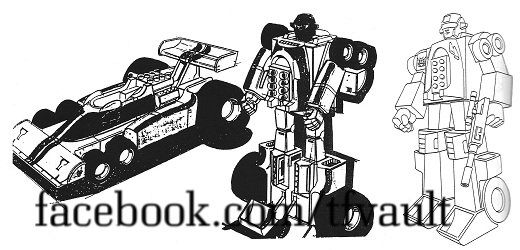
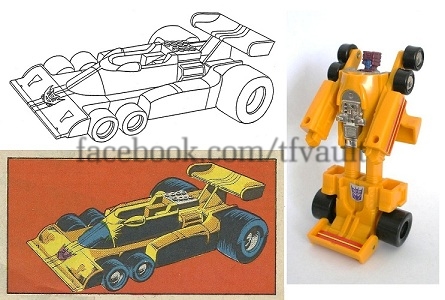
Looking at the robot mode we find that a lot of the same refinements were made to his appearance that were also made to Dead End and Wildrider, and once again a lot of the head design was kept throughout the design process with the visor and the head antennae. Apparently the lower legs should have been separable as well, but that never went into the production toy.
But the one thing that really stands out on Drag Strip, and which explains an otherwise slightly random design choice as compared to how the final toy ended up, is the orientation of the shoulder wheels. On the toy, the two sets of front wheels stay on the arm piece, effectively giving the robot mode a set of wheels placed on top of each other on the character model, the wheels are placed next to one another.
Looking closely at the design sketch, it seems that the original intention was for the front set of wheels to be attached to the vehicle nose piece rather that to the other set of wheels, subsequently given that the transformation of the nose section is still as we know it the wheel pairs end up seemingly placed next to one another. And when cleaned up for the character sheet, it could indeed be interpreted as if they were aligned horizontally on the shoulder of the toy (while removing the unsightly backpack); the split between the front wheel pairs on the vehicle design sketch for transformation is retained on the model on Universe entry, even.
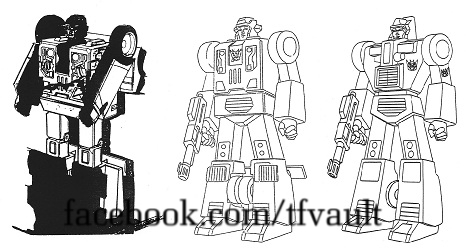
Moving on to Breakdown, we are presented with an even better look at how the initial design evolved from the early sketch through one pass of the character model and into the final and well-known character model. It is very easy to see how the chest details in the unused model are based on the design sketch and then completely revamped and streamlined for the final model, and how the rear wheels (which aren't visible in the design sketch but must be positioned as we know them considering the general structure of the lower legs) were moved to the back of the legs, possibly to streamline that element of the design more. The hood of the car mode is ignored and left out completely on both drawings, while the car mode's rear spoiler seen correctly placed on the back of his legs on the unused sketch is moved up onto his back of his robot mode (not shown).
Motormaster probably has the most interesting depiction, as his show bible entry is very much different than both his appearance as we know it but also compared to the design style of his four team members.
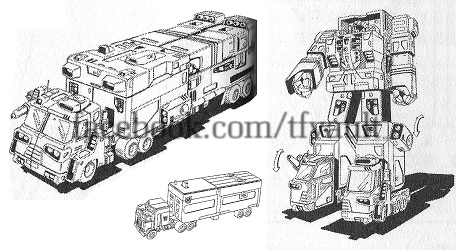
The images used (colored and therefore very dark in the show bible, but presented much clearer here in black and white from a different source) come straight from the "Diaclone: Jizai Gattai" era and are basically very close to his final transformation however sporting a much more futuristic vehicle mode with movable weapons as opposed to the very realistic looking and streamlined Kenworth trailer truck that was eventually used.
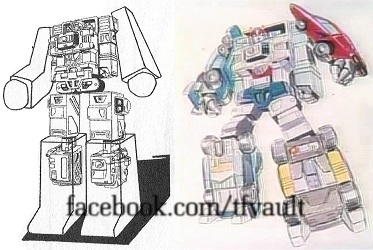
Curiously, the one image completely missing in the show bible is Menasor. As found in other sources, one of the above images may well have been intended to have been printed in there, possibly even added in a later revision of the bible. However, while the two images do contain a lot of what the final toy would have, like the add-on chest and the orientation of the smaller limbs, a few things are still different, notably the head design, the lack of foot plates and the lack of a separate pelvis armor (which seems to be an integrated flip-down plate of the Motormaster design).
The colors also seem very early and clearly not final, of which Drag Strip's blue color is of special interest to NTFA members, as that was the color scheme chosen for the very first NTFA convention toy, Downforce, in 2006 (itself based on the livery used by Tyrell at the 1976 German Grand Prix with driver Jody Scheckter's #3).
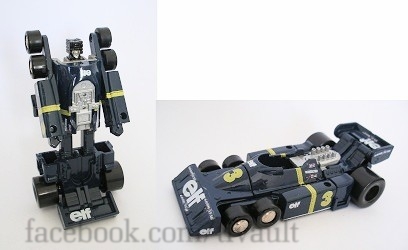
The well-known design image of an Autobot Menasor with upside-down limbs is a curious step away from the "Diaclone: Jizai Gattai" image above and is as such much closer to the fuselage-on-front-legs version of Superion that we saw the last time. Seems like those two designs were meant to mirror one another, but were changed collectively for whatever reason.
Final thoughts
When designing new toys within a limited time frame as might have been the case with the pre-Movie combiners a few shortcuts were inevitable in order to have the toys finished and ready on time. While not finalized, some of the design sketches seem to have been passed along to the character designers, even though a lot of changes still had to be made for the toys. Add a little artistic freedom in how the designs could be interpreted, and some things would emerge on the character models that had no relation to the toys at all visor and faceplate on Superion, antennae on select Stunticons, vertical shoulder wheels on Drag Strip.
While it is fascinating to discover what the origin for these character-defining traits might be, it also gives a glimpse into the design process as a whole looking at the things that came to be, and those that could have been.
THAT'S IT - for now. :) Hope you enjoyed this peek "behind the scenes", and I truly hope that I will be able to present more from the pages of the show bible I have - there are still Protectobots and Combaticons to explore, as well as some other interesting design decisions made late in the proces in regards to the actual toys released (did anyone say rub marks?).
Thank you all for your support, and keep watching this space for more tales From the Vault. :)
Sources:
Special thanks go out to the following individuals:
|
Notes - July 23, 2021
This article was first published on the NTFA message board as episode 13 of "From The Vault", and then archived when the message board was closed down in 2018. Return to main page here. Facebook page: From The Vault - TF Showcase |